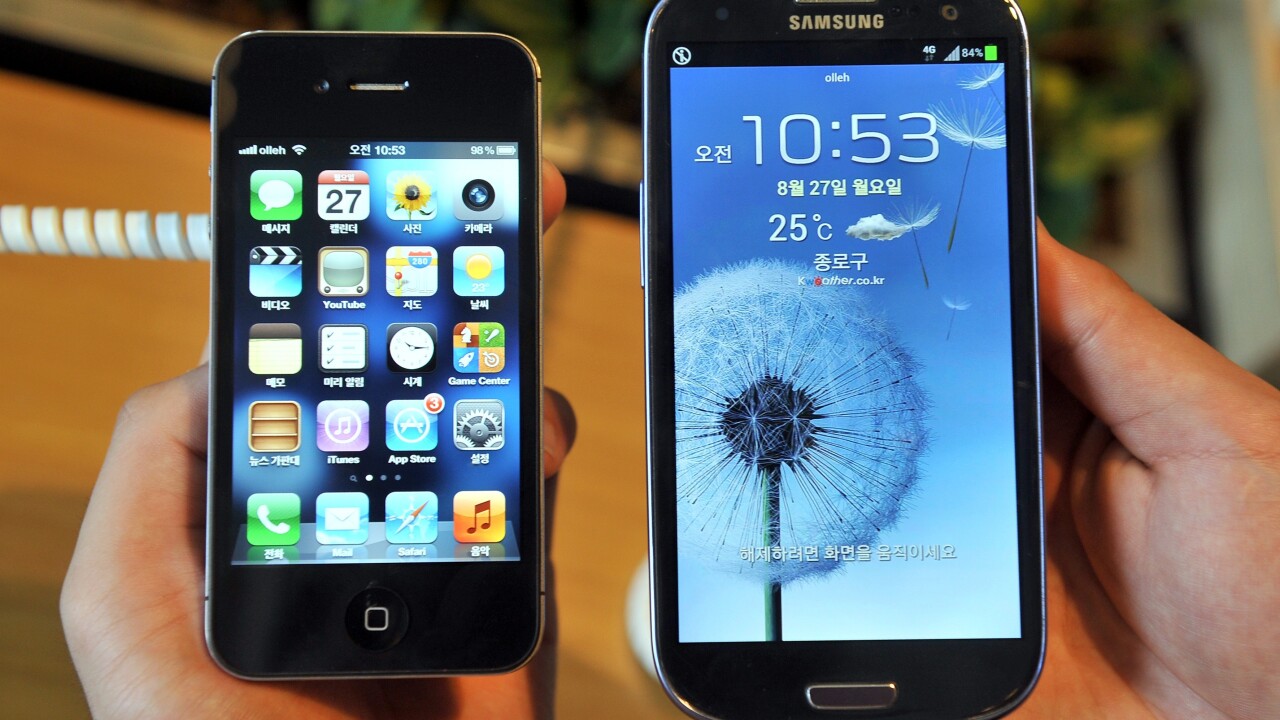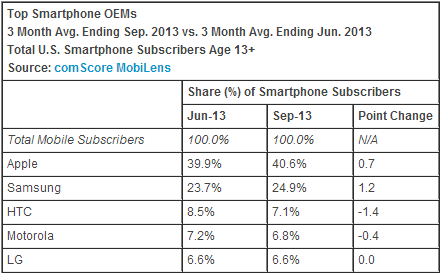
In the US, Apple’s dominance as the top smartphone OEM appears to have temporarily peaked at just above the 40 percent mark. In the last three months, Samsung gained as well, and a bit faster than its main competitor. Rounding out the top five are HTC, Motorola, and LG, all of which lost share or remained flat.
In the platform space, Google is still first courtesy of Android, Apple is second with iOS, but the latter continues to gain on the former. In fact, Android is still losing share while iOS is eagerly pushing onwards. Rounding out the top five are BlackBerry, Microsoft, and Symbian.
The latest data comes from comScore, which regularly surveys over 30,000 mobile subscribers in the US. The market research firm says 147.9 million Americans owned smartphones (2 percent mobile market penetration) in September, up 4.5 percent since June.
During the quarter, here is how the top five smartphones OEMs fared:
As you can see, Apple gained 0.7 percentage points in terms of smartphone subscribers (from 39.9 percent to 40.6 percent) while Samsung gained 1.2 percentage points (from 23.7 percent to 24.9 percent). HTC dropped 1.4 points (to 7.1 percent), Motorola fell 0.4 points (to 6.8 percent), and LG stayed flat at 6.6 percent.
The reason we’re saying Apple temporarily peaked is because it only hit 40.6 percent in comScore’s last report. Apple has been increasing its share more than the competition for months now, but Samsung has managed to gain more in May, June, July, and September.
Samsung and Apple gained a combined 1.9 points while the other three lost 1.8 points together, meaning the duo continues to steal share from smartphone makers not even in the top five, at least in the US. We would have expected Apple’s gains to be higher, given the arrival of the iPhone 5s and iPhone 5c, but those potential gains may trickle out later.
HTC’s woes continue as its One smartphone just isn’t the one. The suggestion that the company may want to consider an Android and Windows Phone dual-boot option has yet to bear fruit.
Meanwhile, Motorola’s Moto X received decent early reviews, but it’s likely poor sales have led to a price cut. LG isn’t bleeding anymore, in part thanks to the G2, and we’re sure the Nexus 5 will help it even more.
On the software side, Google is still dominating, but Apple continues to make steady gains. After four months of losses in a row, Android regained share in May, and then went flat in June. Then it lost share in July, August, and now September:
Samsung’s gains aren’t enough to offset the losses of other Android makers, causing the mobile operating system to lose 0.2 percentage points (from 52.0 percent to 51.8 percent). Apple meanwhile increased its share by 0.7 percentage points (from 39.9 percent to 40.6 percent, just like for its smartphone share).
BlackBerry was down 0.6 points (from 4.4 percent to 3.8 percent), Microsoft gained 0.2 points (from 3.1 percent to 3.3 percent), and Symbian stayed flat at 0.3 percent. BlackBerry clearly isn’t making a comeback with its Z10 and Q10 devices, while Microsoft is on its way into third place.
The Android-iOS duopoly in the US has once again hit a new high (92.4 percent market share). That being said, Windows Phone is beginning to make waves in at least certain countries.
Top Image Credit: Jung Yeon-Je/Getty Images
Get the TNW newsletter
Get the most important tech news in your inbox each week.







